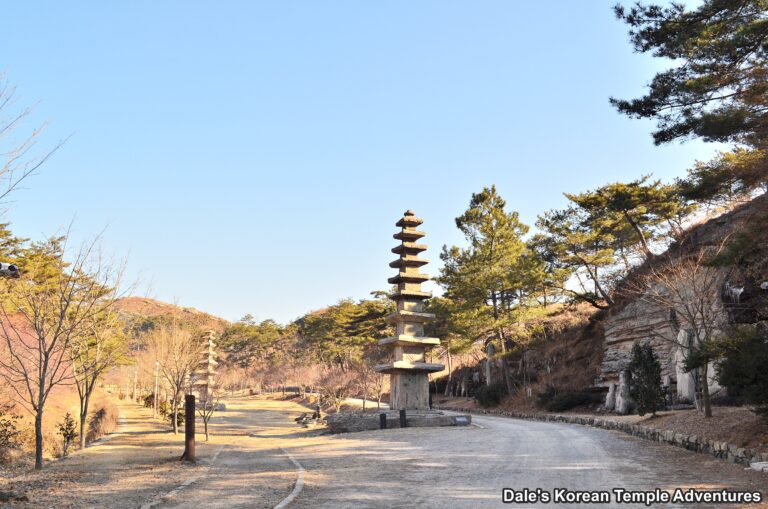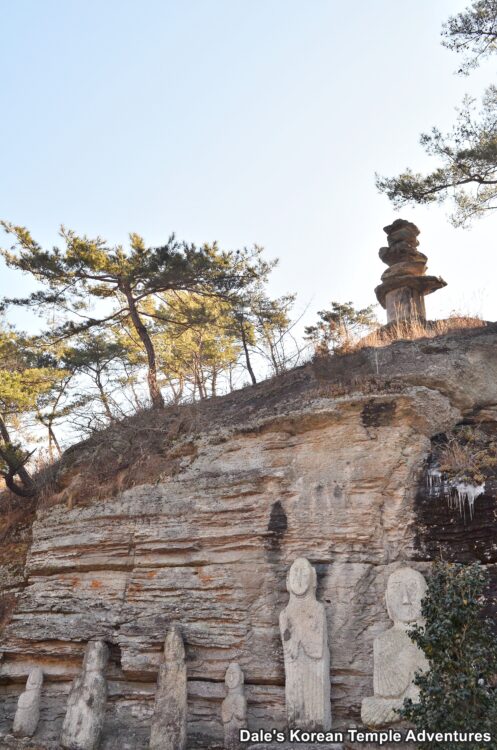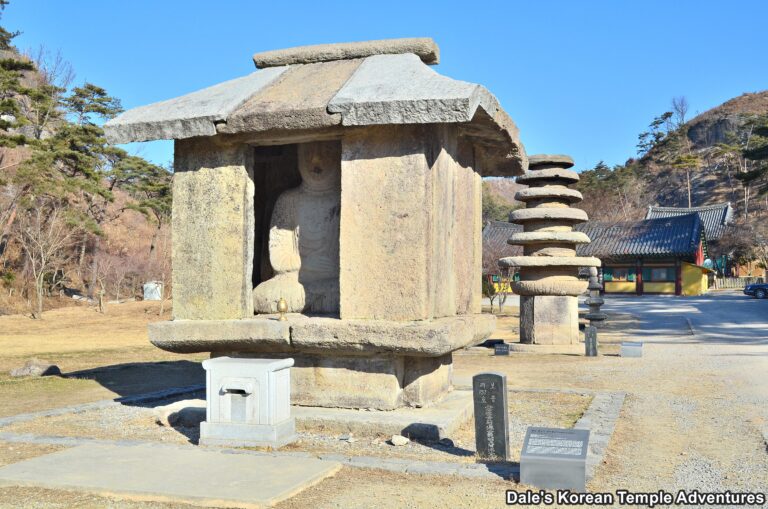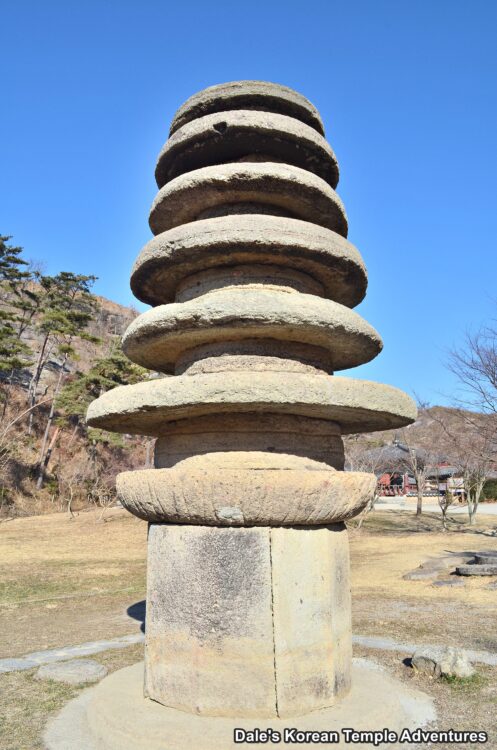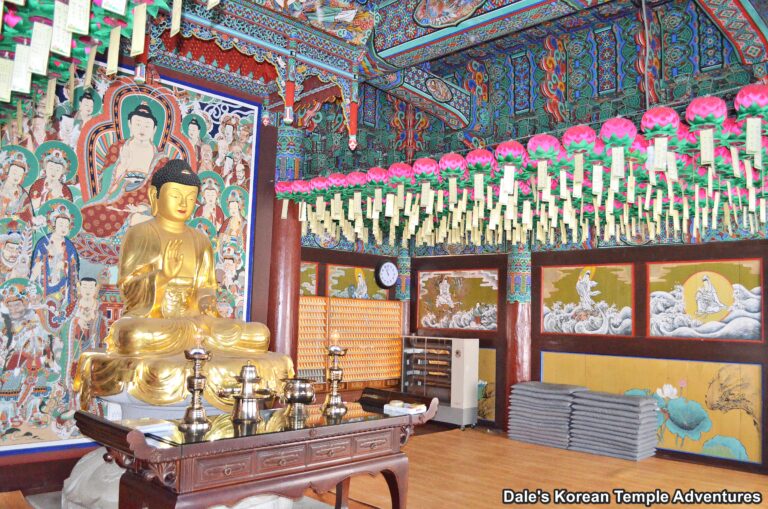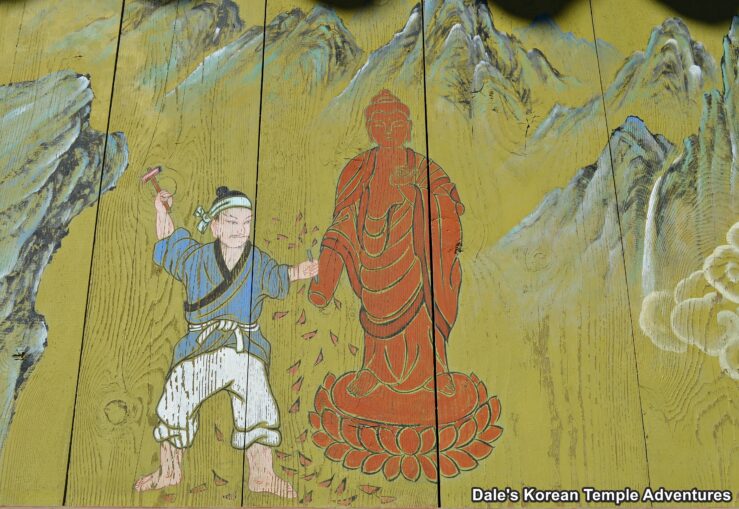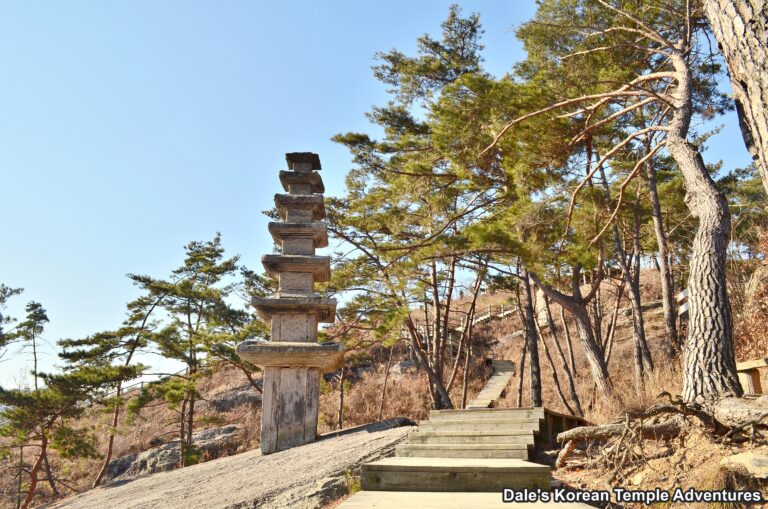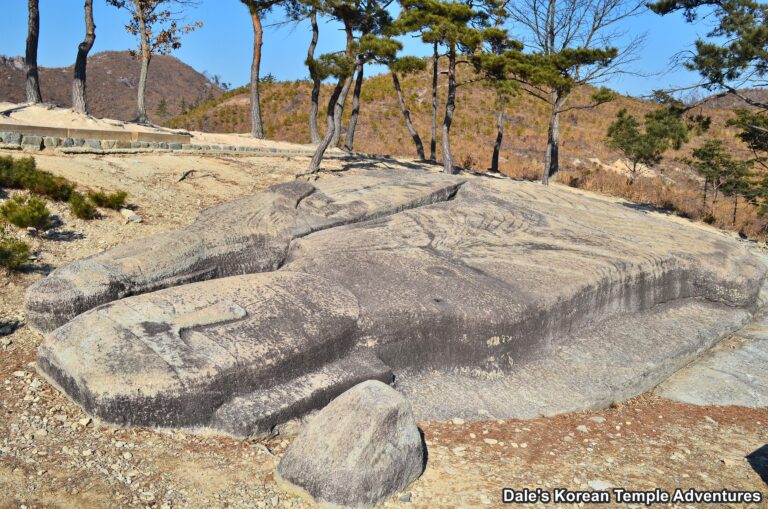Unjusa Temple – 운주사 (Hwasun, Jeollanam-do)
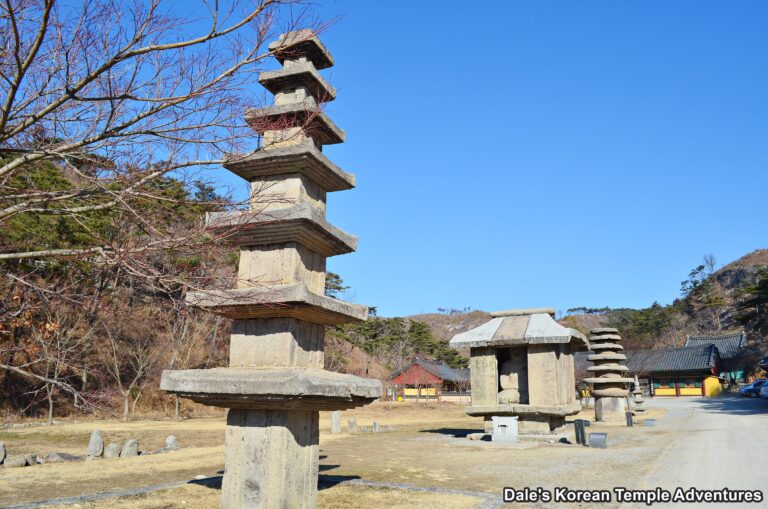
Temple History
Unjusa Temple is located in rural Hwasun, Jeollanam-do. The name of the temple, Unjusa Temple, means “The Place Where Clouds Stay Temple,” in English. The exact date of the founding of Unjusa Temple is unknown; however, it’s widely believed to have been established sometime during the beginning of the Goryeo Dynasty (918-1392) in the late 10th century or early 11th century. Circumstantial evidence indicates that the temple was created by the monk Hyemyeong. And the temple prospered until the 12th century. The oldest historical record about Unjusa Temple is found in the book “Sinjeung Donggukyeojiseungnam” (“A Revised Book on Geography and Scenic Sites in Korea,” in English, from 1530. The nickname “Cheonbulcheontap,” or “Thousand Buddha and Thousand Pagoda,” pertaining to Unjusa Temple, comes from this text. Unjusa Temple is believed to have continued to grow up until 1597 when it was destroyed by the invading Japanese during the Imjin War (1592-98). The temple remained in ruins until the start of the 20th century when the temple underwent a series of reconstruction and renovations.
Most of this information came to light; or rather, resurfaced, as a result of the archaeological efforts of Chonnam National University from 1984-89. These efforts largely dispelled a lingering myth that the famed monk Doseon-guksa (827-898 A.D.) established Unjusa Temple. It’s said that Doseon-guksa founded the temple based on the theory of geomancy. It was believed by Doseon-guksa that the land was a ship. And the centre of this ship was Honam (present day Jeollanam-do). The only problem with this is that there were more mountains in the east than there were in the flatlands of the west. Doseon-guksa was afraid that the ship would tip over. To help counter the sheer weight of this imbalance, and help counteract the potentiality of the west being submerged under the sea due to the weight of the eastern mountains of the region, Doseon-guksa called down stonemasons from the heavens to build a thousand Buddha statues and pagodas at Unjusa Temple. However, before the last Buddha statue could be built, the dawn broke, the cock crowed, and the celestial stonemasons were recalled back to the heavens. As a result, two statues, which can still be seen on the western peak of the low-lying mountain on the Unjusa Temple grounds to this day. As dramatic as this creation myth is, the temple was probably a school for stonemasons.
Temple Layout
Presently, Unjusa Temple is home to some twenty-one pagodas and ninety-four additional sculptures of the Buddha. You first approach Unjusa Temple through a rather wide two-pillared Iljumun Gate. Just a couple hundred metres up the pathway, and you’ll next come to a collection of stone Buddhas to your left in an open field. Continue in this direction, and you’ll finally come to a clearing where the vast majority of the temple’s pagodas and Buddha statues are located. The first of these pagodas is the Nine-Story Stone Pagoda, which is also Korean Treasure #796. This pagoda was created during the Goryeo Dynasty, it stands precisely two hundred metres from the Daeung-jeon main hall, and it’s also the tallest pagoda at Unjusa Temple.
Just beyond this simplistically designed pagoda are a collection of broken stone Buddha heads and bodies. And above this collection, perched on a rocky ledge like a sentinel, is the Five-Story Stone Pagoda. Just beyond this area, and a little further up the sheltered valley, are a pair of Seven-Story pagodas. They’re simply known as the “Chilcheung Seoktap,” in Korean. And to the rear of these two pagodas are a row of stone Buddha sculptures. I know, I know, like I said, this place is packed with Buddhist stone artistry.
Perhaps two of the most intriguing stone monuments at Unjusa Temple lie beyond this row of stone Buddha sculptures. The first is the large-sized Shrine of Stone Buddha at Unjusa Temple, which is also Korean Treasure #797. In Korean, it’s called a “Bulgam.” Not really sure how this isn’t a national treasure, but I’m also not on the select committee either. With that transgression aside, the outdoor shrine was also made during the Goryeo Dynasty. The raw exterior, and the double entryway to the dual doors that adorn the outdoor shrine, make this huge stone monument an extreme rarity in Korea. It’s only one of two in Korea, in fact. And behind this, like a shadow, is the Cylindrical Multi-Story Stone Pagoda of Unjusa Temple. The highly original pagoda is Korean Treasure #798. Most pagodas are either squarish or rectangular in design, but this 5.8 metre tall pagoda contradicts that traditional trend. Instead, this pagoda follows the local stylized trend at that time during the Goryeo Dynasty.
The actual temple courtyard that houses all the shrine halls at Unjusa Temple lies at the end of the valley floor. You pass through a pavilion with Geumgang-yeoksa (Vajra Warriors) adorning its doors. This is the entryway to the temple courtyard. Straight ahead, and out in front of the Daeung-jeon Hall is a slightly damaged Goryeo Dynasty stone pagoda. As for the Daeung-jeon Hall, a solitary statue of Seokgamoni-bul (The Historical Buddha) sits on the main altar. This statue is joined by numerous wall murals of an all-white Gwanseeum-bosal (The Bodhisattva of Compassion). To the left of the main hall is the Myeongbu-jeon Hall. The exterior walls to this hall are decorated with various murals from the underworld. Inside this hall is a golden-capped statue of Jijang-bosal (The Bodhisattva of the Afterlife). This statue is joined by several smaller figurines of himself on all sides.
To the rear of the Daeung-jeon Hall, and slightly up the embankment, you’ll come to two newly built halls. The first one to the left is the Sanshin-gak Hall, which houses and all-red mural of Sanshin (The Mountain Spirit). Just to the right of the shaman shrine hall is another shrine hall; this time, to house sculptures of the Buddha, Seokgamoni-bul. And behind these halls is another row of Buddha sculptures, including a near faceless incarnation of the Buddha. It’s also from this part of the temple that you get a picturesque view of the valley floor below.
The final area of Unjusa Temple that you can explore is to the left of the Daeung-jeon Hall and up the neighbouring mountain. The mountain stands a reasonable, and hikeable, two hundred metres in height. You know you’re getting closer to the summit of the small mountain when you see a pair of Seven-Story Stone Pagodas, as well as a collection of stone statues of the Buddha just below the lip of the ledge that houses the aforementioned twin pagodas. On top of this diminutive mountain lies the pair of twelve metre long stone sculptures of the Buddha from the Doseon-guksa creation myth. They’re called the Stone Statue of the Lying Buddha, and they look as though they’re sleeping. In Korean, they’re referred to as “Wabul.” This well-preserved pair is only one of two in all of Korea. And there’s a wooden observation deck that you can enjoy the pair from. According to legend, when these twin Buddhas wake up, a new era will begin.
Of note, and on the way to Unjusa Temple, there are in fact ten rock quarry sites that were used to create the stone artifacts that you find around the temple grounds. Additionally, there are abrasive marks around these areas caused by the moving of these rocks that created the Unjusa Temple stone masterpieces.
Another interesting point to be made about Unjusa Temple, other than the source of the stones that were used at Unjusa Temple, are the various forms of stone Buddhas and pagodas. They are a mixture of indigenous folk culture like the Chilseong-am rock collection on the western slopes just below the Wabul sculpture. There are stone discs that measure two to four metres in diameter and are placed in the shape of the Big Dipper (“Chilseong,” in Korea; or “The Seven Stars,” in English). The thickness of the stone discs were carved differently to accord for the differences in the brightness of the asterism. This is the oldest astronomical data of these stars in the world.
Another interesting example of the mixture of culture at play in the Buddhist stonework at Unjusa Temple is the Tibetan Esoteric Buddhism influences. This can be seen in the back-to-back Buddha statues housed inside the Shrine of Stone Buddha at Unjusa Temple. Also, the imagery on the pagodas like the Mandala hint at the different art forms at play here like Tibetan and Mongolian influences, as well. Specifically, the diamond (◇◈), X (×,××), vertical lines (∥∥), brackets (〈〉) that are carved onto the various pagodas show a Mongolian influence.
What this all points to at Unjusa Temple is the radical combination of various Buddhisms like China, Tibet, Mongolia, indigenous shamanic beliefs intermingling, which is rare at a Korean Buddhist temple.
Unjusa Temple is on the tentative list of future UNESCO World Heritage Sites.
Admission to the temple is 2,500 won.
How To Get There
To get to Unjusa Temple, you’ll first need to get to the Gwangcheon Bus Terminal. The easiest way to get there is from Gwangju. From the Gwangcheon Bus Terminal, you’ll need to take city Bus #318, which will take about an hour and a half to get to Unjusa Temple. Just be sure when you board this bus to ask the bus driver, “Unjusa?”, just to be safe.
Overall Rating: 9/10
There is just so much to appreciate about Unjusa Temple. And if you’re an archaeologist, or just a person that loves the intricacy of Korean Buddhist masonry, Unjusa Temple is the place for you with its wide variety of stone artifacts that range in influence from Korean Buddhism, to Korean shamanism, to Mongolian, Tibetan, and Chinese Buddhism. The highlights to this temple, besides the sheer volume of stone masonry, are the twelve metre long mountaintop Wabul, the Shrine of Stone Buddha at Unjusa Temple, the Cylindrical Multi-Story Stone Pagoda, and the Nine-Story Stone Pagoda. If you don’t enjoy yourself exploring Unjusa Temple, you simply don’t enjoy Korean temples.
